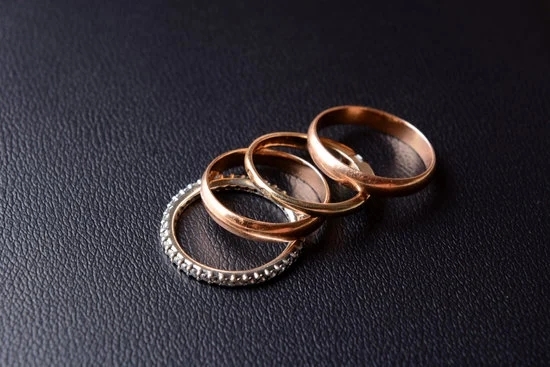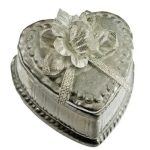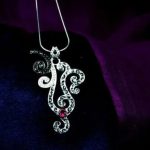When it comes to jewelry making, the most essential requirement is the right raw material. This includes gems and stones, precious metals such as gold, silver and platinum, pearls, shells and a variety of precious metals. There are also different types of metal alloys used for forming jewelry pieces. Each of these raw materials play an important role in creating beautiful and unique jewelry that will be treasured for many generations to come.
Gemstones: A Variety of Precious Metals
Gemstones and precious metals are the two main components used in creating beautiful jewelry pieces. While gemstones such as diamonds, rubies and sapphires have become more popular over the years due to their rarity, other gemstone options such as amethysts and turquoises are also becoming increasingly popular due their vivid colors.
When it comes to precious metals, gold continues to dominate in terms of beauty but silver and platinum are also growing in popularity among consumers who enjoy a more lustrous look. Other precious metal choices may include palladium which is commonly known for its greater durability compared to existing gold-alloy bridal sets or rhodium with its shinier white surface that never tarnishes at all.
Alloys: Mixes That Create Unique Results
In addition to pure forms of gold and silver, alloyed metals can enhance color or strength depending on the chosen combination of base metal with other added elements like nickel or zincThe desired effects could be achieved when combination with other member like copper which involves purity level such as 9 carat (pale) 14 carat (yellow) & 18 carat (darker yellow).
Apart from creativity possibilities , alloys offer more economical solution compared to pure forms.Should one choose make Jewelry pieces in considerable large quantity then possibility for alloy material cost saving is high.
It open up immense variety in terms designs , size & fitting , so one can look at it creative way rather than looking at purely cost benefit perspective.Alloy base materials are perfect option if custom manufacturing needs higher yield rate & customer require faster turn around times.
In short ,for any given design making choice from wide range of alloy base material gives more flexibility toward achieving economic yet attractive result. Ultimately preferences comfort level may dictate final selection .
Common Metals Used in Jewelry Crafting
Jewelry making is an exciting craft that allows you to express your creative flair and put together stunning designs. It requires raw material, such as metals, to form the basis of the jewelry piece. One metal which is often used today is sterling silver.
This metal contains 92.5% pure silver, combined with alloys in order to produce a hard-wearing metal for jewelry crafting. Sterling silver has a wonderful shine, which makes it ideal for pendants and necklaces. In addition, because it is softer than other metals, there are plenty of techniques novice jewelry makers can use to shape or mould it without intricate tools or gadgets.
Other popular metals used when crafting jewelry include brass and gold fillings. Brass is normally composed of copper and zinc and can be plated with gold to create unique pieces of jewelry with a luxurious look and feel.
Gold fillings are more valuable than sterling silver as they contain more pure gold mixed with alloys. This creates a stronger metal that has greater luster too, making it perfect for accentuating jewels like diamonds or rubies in bracelets or even engagement rings.
Finally, one of the oldest metals used in jewelry craft is copper alloyed with tin (pewter). Pewter dates back centuries ago when they were typically cast into items such as goblets or tankards – known as pewterware – but today they’re mostly employed to create sturdy pieces of jewelry that boast ornamental patterns.
Also known for its antibacterial agents, some costumes makers even choose to make accessories from pewter by employing unique objects such as feathers, glass beads and charms made from the same material.
Types of Precious and Semi-Precious Gemstones
The term “gemstone” refers to any type of stone that can be cut, polished, and used for jewelry-making. In general, gemstones are divided into two categories: precious stones and semi-precious stones. Precious gems are the most sought after and generally have a greater value since they are more rare.
The best known examples of precious gemstones are diamonds, rubies, sapphires, emeralds and opals. However there are many other types of stone that fall into this category that may not be as well known such as tourmalines, amethysts, spinel and garnets.
Semi-precious or secondary gemstones come in a wide range of shades, shapes and sizes. Popular stones in this category include aquamarine, hematite, moonstone, peridot and quartz crystals.
People often opt for semi-precious stones when making pieces of jewelry on a budget as they tend to be more affordable. Semi-precious gemstones often have unique stories attached to them due to their mythology or folklore – such as aquamarine being associated with the idea of protection at sea when sailors were out on long voyages.
For many centuries people have been using these precious and semi-precious gemstones to create exquisite works of art ranging from jewelry to decorative objects such as carved figures or inlaid furniture pieces. This history is still alive today as many master jewelers continue to combine state-of-the art technology with traditional techniques like chiseling or setting by hand to make incredible pieces for their customers.
With the vast selection of different types of raw materials available for jewelers today, it’s easy to find something that would make an amazing gift for someone special or simply express your own sense of style.
Natural Elements Used in Creating Jewelry
Natural elements such as metals, wood, leather and stones are often used to make jewelry. Gold, silver and bronze are the three main metals that are commonly used to create earrings, bracelets, necklaces and other pieces of jewelry. These metals can be manipulated at a hot or cold temperature depending on what type of finish is important for the design.
Metals can be bent and cut relatively easily so they are perfect for crafting different designs with intricate patterns. Another popular material used in making jewelry is wood which adds an earthy color and texture to pieces. Wood beads and charms can provide unique visuals to a piece of jewelry beaded onto cotton or leather string.
Leather is another customary raw material used in creating attractive pieces of jewelry. Genuine leather has a wide range of colors available as it is derived from animals whose coloring ranges drastically in shades.
Leather also has a natural texture giving it smoky appeal when crafted into intricate patterns such as bangle style bracelets or earrings made out of single strips funneled together like scales – this effect is known as featherweight earrings or bangles.
Lastly comes stones which bring an array of options both natural and engineered – from Mookaite Jasper to Turquoise dye-stained glass exclusive blends to always highest quality diamonds these materials have many components that give each one their own interesting characteristics when put into practice for creating beautiful adornments.
Each element provides many possibilities when creating trendy new looks with traditional methods in mind amongst evergreen styles with modern twists – sometimes multiple materials are even incorporated together for a truly captivating result leaving admirers speechless alike.
Pendants with wooden plants embedded inside glass vial pendants, solitaire sapphire cuffs surrounded by silver roping or star-shaped charms made entirely out of gold attached onto leather straps can all be created using these various raw materials providing a truly unique collection not shared across any marketplace worldwide.
Specialty Raw Materials Used in Unique Jewelry Designs
Raw materials for making jewelry come in a variety of types, ranging from metals and precious gems to synthetic materials. Choosing the right raw material can be crucial to an individual’s jewelry-making process. For one thing, the chosen material needs to be suitable for the design outcome sought.
Additionally, preferences will often dictate the kind of material needed. Some jewelry makers prefer expensive metals that symbolize wealth and prosperity, such as gold and platinum. Others look for cheaper alternatives, like sterling silver and brass.
When it comes to creating unique designs for jewelry items? Many artisans opt for specialty materials that are not typically used in commercially made pieces. These specialty materials add an artisanal flair to jewelry pieces; allowing them stand out from mass-produced items.
Materials such as rose quartz, lapis lazuli, coral beads, serpentine stones and horn beads create very interesting patterns which have minimalism yet stand out from other traditional items in the same fashion line. Wooden elements are also increasingly adopted by budding designers since it ensures an eco-friendly stance of their brand while still yielding gorgeous aesthetically pleasing results when made into a piece of craftwork.
Moreover , synthetic materials such as colored glass beads or crystals bring vibrancy and audacity to the project; complementing choice fabrics or precious metals used in tandem with the colorful accents implemented throughout the design. Synthetic versions of certain jewels also provide crafters with greater flexibility compared to natural versions which might already exist but lacking potentials due to limited resources available in nature ; all this further elevate custom jewelry pieces crafted by hand significantly .
Ultimately , these new designs add a freshness of sophistication no matter what type of accessory is being created All-in-all speciality raw materials used in unique jewelry designs add life and fun into crafting accessories whether its a necklace , bracelet or ear ring.
The Benefits and Drawbacks of Various Materials
Jewelry is a great way to express yourself and showcase your personal style. While many people are content with using metal, stones, and crystal as the raw materials for their jewelry, there are many more to choose from. Each material has its own benefits and drawbacks depending on what type of design you are looking for in your end product.
Gold is a popular precious metal used for making jewelry due to its beauty and durability. Gold is easy to shape and hold intricate designs, but it does come with a high price tag so it may not be an option for everyone’s budget. It also takes more maintenance than other metals because it can tarnish over time.
Silver is another commonly used metal for jewelry due to its affordability compared to gold or platinum. Silver can be just as durable as gold if properly cared for but will tarnish if exposed to harsh elements or chemicals. It’s also not as malleable as gold so your design options could be limited when creating intricate pieces.
Gemstones like rubies, sapphires, and diamonds are also commonly used in jewelry-making as these materials boast beautiful colors that add personality to designs. However, gemstones are expensive and require specific care instructions so they don’t lose their luster over time. Synthetic gems like cubic zirconia provide affordable alternatives that offer much of the same look without the hefty price tag or strict maintenance routine associated with genuine gemstones.
Finally, crystals like Swarovski offer even more options when creating unique pieces of jewelry that truly stand out from the rest. These look great when combined with metals or gemstones but come with their own set of downsides – they’re not very durable so they can chip or break easily if handled improperly and some may not have the same sparkle or shine that genuine gems have since they lack natural radiance or reflective qualities.
No matter what raw material you choose for your next piece of jewelry-making project, it’s important to do some research beforehand about the pro’s and con’s of each one ahead of time in order ensure you get exactly what you want out of your final product.
Steps for Choosing the Right Raw Material for Your Jewelry Design
When you are a jewelry designer, the raw material you choose to use can make or break the success of your piece. From metals to gemstones to beads, selecting the right material for each design is an essential part of the creative process. To ensure that you have chosen the best raw materials for your work, follow these steps:
The first step in selecting quality raw materials is determining your budget. While some raw materials such as gold can be quite expensive and tricky to work with, other material such as plastic beads may be less expensive and more accessible. Deciding how much money you will spend on each item determines which types of raw materials will be available for your projects.
The next important step is gathering information about each type of material you are interested in using. Researching what options exist for different categories like metals, precious stones and artificial stones should give you an idea about their pros and cons and help you decide which is best for each project.
Finally, it’s crucial to apply these findings in a practical manner when actually selecting pieces to use. Look up the various sources from which gems or beads are sold and inspect them carefully before buying them. Compare prices while taking into account quality grades, certifications, color or other factors that might contribute to making one product more attractive than another. Doing this research before every purchase can save time and money.
Once you have taken all these steps into consideration in choosing raw material outlets that fulfill both quality requirements and budgetary concerns sure makes it easier to feel comfortable with any decision taken when starting a new project. Hopefully now you are fully equipped with seek out and find the perfect mix of supplies needed to create your next masterpiece.
Examples of Popular Pieces Made with Each Type of Raw Material
Jewelry making is a wonderful craft for those looking to express their creativity through fashion. The type of raw material that you choose is essential to having a successful product as each material will hold its shape differently and have a different look. Popular materials used in jewelry making often include metals, gemstones, beads, synthetic materials, and several other options.
Metals are some of the most popular materials used for jewelry due to their strength and durability; they are also quite affordable compared to other options. Examples of popular pieces made from metals include rings, bracelets, earrings, chains, and even intricate sculptures.
Depending on your budget you can use silver or opt for something higher – end like gold or platinum as well. Keeping in mind the look you want is important when deciding on the metal because each has its own unique appearance.
Gemstones add another level of beauty and royalty to jewelry; they too come in a variety of styles that are tailored to suit all budgets. For example, cubic zirconia provides the same bling factor as diamonds but at a much lower cost while other precious gems like rubies or sapphires give an added elegance to any piece regardless of design or size.
Common pieces that are created using these stones include engagement rings, necklaces and pendants with multiple stones randomly set like flower petals along a vine pattern. Agates make beautiful cabochon cut rings or even earrings set into more ornate designs such as filigree chasing backs which adds more visual appeal in comparison with smooth – backed ones.
Beads can also provide unique textures and colors when designing jewelry. Popularly used elements include semi-precious gemstones like turquoise which gives off warm properties while creating certain ethnic vibes or something less flamboyant like freshwater pearls provide classic romantic influences epitomizing luxury & elegance at the same time; not forgetting those big statement items made from brightly colored crystals which add that extra sparkle.
Choosing an appropriate number & size of beads depend on personal preference – commonly one can find chokers with random sized round beads interwoven into various patterns such as spirals & chevrons whilst necklaces have symmetrical organized shapes like squares/triangles etc for more subtle effects instead.
Tips on Where to Find Quality Raw Materials
When making jewelry, having easy access to raw materials is very important. Many people prefer to shop online since it offers a greater selection of items and the convenience of being able to shop from home. But it can be difficult to find quality raw materials online, especially if you’re unfamiliar with the different types and qualities that are available. Here are some tips on where to find quality materials when making jewelry:
The first option for finding quality raw materials for making jewelry is at local craft stores and hobby shops. These stores usually carry a wide variety of items which can be used to create beautiful pieces of jewelry, from beads, findings and wire wrappers to chains and cabochons.
It’s always a good idea to read reviews before buying from any store, as these will give you an idea of the type of products they sell and the quality of the material you’ll receive.
Another great source for finding reliable raw materials is at your local bead store. Bead stores typically carry an array of tools, supplies and components specifically tailored towards making jewelry such as stringing supplies, pendants and charms, clasps and crimp tubes. Look for stores that have knowledgeable employees who can answer questions about different types or brands of materials or give advice on what works best in certain situations.
Finally, specialty craft magazines often provide detailed instructions with pictures on how to get started creating one-of-a-kind pieces using rarer or unique artifacts like vintage findings. Or search online databases such as Etsy’s indie designer collection where artisans can showcase their work while providing tips on the sources they use for their raw materials. This way buyers don’t need to travel far from home in order to purchase quality items from specialist sellers.
With these tips in mind, finding quality raw material for making jewelry should be no problem at all. Keep these sources in mind when searching for everything you need when crafting amazing pieces that look professional yet retain their own personality.
Finishing Touches to Add Value to Your Jewelry Design
When it comes to raw material for making jewelry, there is a wide selection of materials you can use. Whether you are creating a piece from scratch or re-purposing an old piece, selecting the right raw material can make a great impact on the finished product. Popular raw materials used in jewelry design include sterling silver, gold, brass, copper, titanium and stainless steel.
Depending on the application and budget, different metals will produce different effects when used together. The combinations of these metals with precious stones, semiprecious stone beads and crystal beads impart a unique character and texture to your jewelry piece.
The type of plating finish you select will also affect the outcome of the final product because it improves the appearance of the metal pieces while adding durability at the same time. Plating is an economical process that adds value to your jewelry by providing an eye-catching visual appeal with little extra cost incurred during production.
Common plating finishes used in jewelry designs include gold platting for yellow shades as well as rose gold or rhodium platting for black or silvery whites.
In addition to metal pieces and plating options, adding decorative items like charms or preciosa crystals can turn your piece into something extraordinary. Charms give an added element of personalization to make each item one-of-a-kind.
Preciosa crystals are an excellent way to add vibrant colors with subtle sparkle that reflects light beautifully in any surrounding environment. With all these design elements combined, you can easily create stunning pieces that look great no matter where they’re displayed; on a body chain or as part of an intricate earring set – whatever your preference may be.

Welcome to my jewelry blog! My name is Sarah and I am the owner of this blog.
I love making jewelry and sharing my creations with others.
So whether you’re someone who loves wearing jewelry yourself or simply enjoys learning about it, be sure to check out my blog for insightful posts on everything related to this exciting topic!





